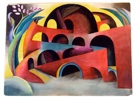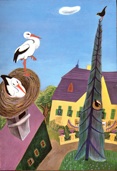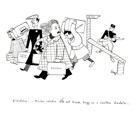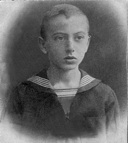About Tibor Gergely
1900 -1978

About Tibor Gergely
1900 -1978
“In 1919 I happened to pass some paintings by Goya and Cezanne leaning against a fence in Bulyovszky Street in Budapest and my career as an engineer got its final blow. ”
Drawing on a pier in Cape Ann

Bela Bartok
Most came from the assimilated Jewish middle class in Hungary and held progressive views. Gergely, the youngest, practiced his uncanny talent for caricature each Sunday while listening to their impassioned discussions and arguments. While they tried to solve the problems
of individuals and society, he captured them in action. Today, his caricatures, many of
which are housed in the Hatvany Lajos Museum in Hungary (others, in our private col-
lection, are on this website) provide invaluable commentary on the eminent members
of this lively group during spirited political and philosophical discussions. “Caricature is
distortion” Gergely said, “and distortion is one way to find the truth.”
Gergely’s search for the truth may have led him to the Sunday Circle but once he was a regular member there, he also found love. Renowned artist, writer and free spirit Anna Lesznai was fifteen
years older than Gergely, and the estranged wife of politician Oscar Jaszi. She delighted in the world of her home, frequently hosting a salon and artist’s colony in her family’s small castle in the village of Kortvelyes. Lesznai was celebrated for her poetry and her intricate and colorful watercolor designs, which she gave to local women to embroider. Today, her work is renowned in Hungary and Europe.

Josephine Baker

Scenic Design
While residing in Vienna, Gergely received the only formal training of his artistic career when he enrolled as a special student at the Vienna Academy for Industrial Art, where he studied lithography for one semester. He began to make a name for himself by illustrating books published in German and Hungarian.

Wheel on the Chimney

Within his family, art was not relevant. Gergely’s father died young and his mother worked in a factory to support the children. Because he was rarely without his sketchbook, his family predicted “he will be a good engineer.” His career path changed when he was twelve, however, the first time he encountered drawings and paintings by modern Hungarian artists on the walls of a school-friend’s apartment.
“A vague desire to paint was implanted in my subconscious” Gergely said, at the sight of these works by Ferenczy, Uitz, Kernstok and Mednyanszky. The power and beauty of the images took root in his senses. His desire to become an artist was reinforced when he was nineteen and happened to “pass some paintings by Goya and Cezanne leaning against a fence in Bulyovszky Street in Budapest.”
By then, Gergely’s interest in art and culture had blossomed into a passion, leading him to become a “junior member” of a prominent group of Jewish Hungarian intellectuals known as the “Sunday Circle.” Its participants comprised a formidable force in Hungarian cultural history. The young philosophers, musicians, writers and artists included Georg Lukacs; Karl Mannheim and Arnold Hauser; film maker and theorist Bela Balazs; Bela Bartok; artist and poet Anna Lesznai and others.
Gergely fell under the powerful spell of Lesznai, as well as the beauty and peace of her family’s estate. She became his muse, as she was for many Hungarian intellectuals. Under her influence, he began to paint with oils and to expand his mastery of drawing. Their affair would eventually lead to marriage and survive their immigrations to Vienna, and then America, where their love lasted for the remainder of their lives.
In 1921, after WWI, a reactionary government came to power in Hungary and most of the Sunday Circle fled Budapest for Vienna. Gergely and Lesznai were among these émigrés of intelligentsia who would remain in exile there for the next decade.
In Vienna, Gergely became a successful caricaturist for Der Tag, a Viennese daily newspaper founded by Sigmund Bosel. Among the prominent theatrical figures he
caricatured were American entertainers Paul Robeson and Josephine Baker. (One of his caricatures of her now hangs in the Smithsonian National Portrait Gallery). He also designed costumes for E. K. Manner’s well known puppet theatre, the
Gildene Pawe, and became co-founder and scenic designer of the avant garde theatre, “Gong.”
In 1931, after a more tolerant government came to power in Hungary, the exiled intellectuals returned. Gergely and Lesznai took up residence in Budapest and spent idyllic summers in the village of Kortvelyes, where they continued to paint. As Gergely illustrated books and drew cartoons for publications, his reputation as a graphic artist grew, along with his expertise in fine art.
During this time, both Lesznai and Gergely delighted in portraying her beloved family estate in their art. Lesznai depicted it as a magical castle with fairy tale gardens. In Gergely’s work, it was often seen as a yellow house with a maroon roof, delicate iron grillwork on the windows and green shutters. This house would later make an appearance in countless American Little Golden Books he illustrated in the late 1930’s and 1940’s. Like Al Hirschfeld’s ‘Nina’s’, Gergely’s depictions of the beloved house are hidden in Tootle the Engine, Scuffy the Tugboat, The Little Red Caboose, Wheel on the Chimney and many of his other children’s book classics.
In 1935, Gergely co-founded the “Atelier Art School” in Budapest, where he taught drawing and illustration. He also became a member of an artist’s society known as KUT. In 1936, he was given a solo exhibition at the Tamas Gallery in Budapest (you can see a sampling in “Oil Paintings.”)
Painting at the “castle”
In 1939, when it became clear that the German annexation of Austria and Czechoslovakia would extend to Hungary, Gergely and Lesznai immigrated to America, where they would live for the rest of their lives.
From the minute he set foot on the island of Manhattan, Gergely was intoxicated by its buildings, skylines, bridges and bustle. This great love is evident in his sophisticated and charming glimpses of the city he made his American home. He drew inspiration from the brashness and dynamism of the fast-paced skyscraper megalopolis (see them in “New York City.”)
During their first summer, Gergely and Lesznai ventured to Cape Ann where he created dozens of line drawings and gouaches depicting life in small towns and seaports (see them in “Americana”). As he had in Hungary, Gergely roamed the countryside, sketchbook in hand. He and Lesznai would return to New England for many subsequent summers, both artists creating countless works of small towns in Cape Cod and Cape Ann until her death in 1966.
Gergely’s career as an American illustrator began shortly after arriving in New York when he met Georges Duplaix, head of production at Artists and Writers Guild. In 1940 they collaborated on Topsy Turvy Circus and The Merry Shipwreck was published the following year.
In 1942, when Duplaix became head of the new Graphics Department at Simon and Schuster, he introduced Gergely to Lucille Ogle, the author who was instrumental in creating Golden Books. She became his editor for many years and he soon became one of the most beloved Golden Book illustrators. Over the course of his illustrious career, Tibor Gergely created iconic images for more than seventy Little Golden Books.
Scuffy the Tugboat and Tootle the Engine. With Margaret Wise Brown (author of Goodnight Moon), Gergely illustrated Seven Little Postmen and Five Little Firemen.
Also in the 1940’s, Gergely contributed many political cartoons to Free World; worked for several advertising agencies as a commercial artist and produced covers for The New Yorker (see them in “New Yorker Covers”.)
Time Square
In the early 1950’s, he again collaborated with Margaret Wise Brown on the Wheel on the Chimney, published by Lippincott in 1954, for which he was awarded a Caldecott Honor the following year (see some of those award-winning illustrations in “Wheel on the Chimney“ ).
Tibor Gergely was born in Budapest in 1900. He was a shy, slender boy with a keen eye for his surroundings. He began to draw at an early age. In school, he expressed his mischievous sense of humor by sketching cartoons of his teachers on the blackboard with astonishing speed while they were out of the room. He was once expelled for leaving a caricature of Emperor Franz Joseph on the board after recess. But not even Gergely had an inkling that these pranks had anything to do with art.
Gergely and Lesznai were invited to join the modernist artists’ group, the Hagenbund (founded in 1900 by Joseph Urban, members included Heinrich Lefler, Joseph Floch, Georg Ehrlich, and Franz Lurch; associates included Anton Hanak, Oskar Laske, Oskar Kokoschka and Egon Schiele.) Gergely was considered their finest draftsman and both his and Anna Lesznai’s paintings and works on paper were frequently included in Hagenbund exhibitions in Vienna.
Using pen and ink, Gergely wandered through the village and country- side, stopping to draw scenes that caught his eye - peasants working in the fields or drinking in the local tavern; women harvesting sweet potatoes; Jewish markets and Jewish weddings; young Gypsy girls bathing in the river; villagers buying and selling at the marketplace; old women gossiping by a fence. Today, these drawings of rural life in villages between the World Wars, depicting the pre - Holocaust assimilation of
In Kortvelyes, Gergely resumed his drawings of village life. It was there that he felt most alive and at home. He later wrote of “the infinity of spring and autumn, earth and sky, life and death” that he felt keenly in those years in the countryside.
Jews mingling with non-Jews in quiet harmony, stand as a record of a vanished world (see them in “Village Life”).
With Gertrude Crampton, he created two of the most famous children’s book characters of all time-
In 2007, Gergely’s work was celebrated in Golden Legacy: How Golden Books Won Children’s Hearts, Changed Publishing Forever, and Became an American Icon Along the Way, by Leonard S. Marcus. Currently, many of Gergely’s original illustrations are touring nationally in the largest public showing ever of original art from Golden Books: “Golden Legacy: Original Art from 65 Years of Golden Books”. This exhibition from the National Center for Children’s Illustrated Literature will continue until 2012.
Gergely’s fine art, which has been seen far less than his illustrations, has nonetheless been acquired by the ALBERTINA, Vienna; Museum of Fine Arts, Budapest; the Fogg Museum, Cambridge, MA and many others (see Exhibitions).
Throughout the 50‘s and 60’s and 70’s, Gergely continued to illustrate Little Golden Books and enriched his “Americana” portfolio, producing gouaches, watercolors and ink drawings in the many places he visited - Boston, Cape Cod, New Orleans, San Francisco, the Rocky Mountains, the Catskills and New Paltz, New York (see them in “Drawings” and “Americana.”) He also illustrated for Sesame Street Magazine.
Tibor Gergely died in New York on January 13, 1978. Shortly afterward, artist and friend Greta Schreyer, to whom he bequeathed his artistic estate, discovered about two dozen rolled up canvases in his closet - oil paintings he had brought with him from Europe and never shown to even his closest friends. She subsequently had the paintings restored and exhibited internationally over the next decades (see them in “Oil Paintings.”)
In 1986 and 1987, exhibitions of Tibor Gergely’s paintings and drawings from 1925 to 1938 were seen at Ingber Gallery in New York and Fairleigh Dickinson University in New Jersey. In 1993, the Belvedere Museum in Vienna included his work in a major exhibition of Hagenbund artists 1900-1938. In 1997, Kunsthandel H. Schrammel gave Tibor Gergely his first solo exhibition in Vienna. His paintings and works on paper have also been exhibited in several group shows.
Today, the magical and mechanical creations that emerged from Tibor Gergely’s brush have captivated children and adults for the past 70 years. His illustrations are renowned and beloved throughout the world.
As of 2001, Tootle the Engine was the third all-time best selling hardcover children’s book in English. Scuffy the Tugboat was eighth on the list.
An original illustration by Tibor Gergely from The Merry Shipwreck is currently on display at the Skirball Cultural Center in Los Angeles in “Monsters and Miracles: A Journey through Jewish Picture Books.” In August, this traveling exhibit will go to the Eric Carle Museum of Picture Book Art in Amherst, MA.
(By Linda Schreyer with special thanks to: Alice D. Schreyer, “Scuffy, Tootle and Other Creations by Tibor Gergely”, Columbia Library Columns, February 1979; Leonard S. Marcus, GOLDEN LEGACY: How Golden Books Won Children’s Hearts, Changed Publishing Forever, and Became an American Icon Along the Way (Random House); Diane Muldrow, Editor Little Golden Books, Random House; Judith Marcus, Greta Schreyer, Leslie Schreyer, Lynn M. Holley and Terry Crowe.)


















